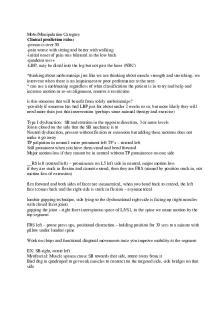Lecture notes, lecture Logarithms PDF

| Title | Lecture notes, lecture Logarithms |
|---|---|
| Course | Calculus for Business and Social Science |
| Institution | Northern Illinois University |
| Pages | 13 |
| File Size | 189.4 KB |
| File Type | |
| Total Downloads | 47 |
| Total Views | 152 |
Summary
Download Lecture notes, lecture Logarithms PDF
Description
Logarithms Professor Richard Blecksmith [email protected] Dept. of Mathematical Sciences Northern Illinois University http://math.niu.edu/∼richard/Math211 1. Definition of Logarithm For a > 0, a 6= 1, the logarithm function y = loga(x)
means x = ay
a is called the base of the logarithm That is, the logarithm function loga is the inverse of the exponential function ax . Just like the square root function is the inverse of the squaring function.
2. Examples 32 = 9 becomes log3 (9) = 2 106 = 1000000 becomes log10 (1000000) = 6 log6
1 = −2 because 6−2 = 36
1 36
log2 (x) = 6 becomes 26 = x 43/2 = 8 becomes log4 (8) =
3 2
y = loge (x) becomes x = ey 1
2
3. Rules of logarithms Algebraic Rules: (1) loga(mn) m = loga(m) + loga(n) (2) loga = loga(m) − loga(n) nk (3) loga(m ) = k loga(m) (4) loga(1) = 0 and ln(e) = 1 Inverse Rules: (5) loga(ax ) = x (6) aloga (x) = x Change of base rule: 7. loga b logb c = loga c
4. Examples log10 6x = log10 6 + log10 x log10
x = log10 x − log10 100 = log10 x − 2 100
log2 (75 ) = 5 log2 7 log10
√
x = log10 x1/2 =
1 log x 2 10
5. The natural logarithm In calculus, the most commonly used base, by far, for logarithms is e. The natural logarithm—written ln—is the logarithm to the base e: ln(x) = loge (x) The function ln is a key on your scientific or graphing calculator.
3
6. Rules of natural log Algebraic Rules: (1) ln(mn) m = ln(m) + ln(n) = ln(m) − ln(n) (2) ln n k (3) ln(m ) = k ln(m) (4) ln(1) = 0 Inverse Rules: (5) ln(ex ) = x (6) eln(x) = x Change of base rule: 7. loga(x) =
1 ln a
ln(x)
7. Rules of natural log The change of base rule 1 ln(x) ln a allows your calculator to compute logarithms to any base: loga(x) =
Example: log2 (7) = ln 7/ ln 2 = 1.945910149/.6931471806 = 1.348802133
8. Derivative of ln x Let y = f (x) = ln x Rewrite y = ln x as an exponential function ey = x or ef (x) = x Now differentiate both sides of this equation with respect to x: d d f (x) e = x dx dx ef (x) f ′ (x) = 1
4
So f ′ (x) =
1 ef (x)
=
1 x
9. What’s important about ln x The single most important fact about ln x is that
The derivative of y = ln x is y ′ =
1 x
There is no power function y = xn that has this property. For if we try to find a value of n such that d n x = nxn−1 = x−1 dx we see that n − 1 = −1 or n must be 0 But the function y = x0 is just the constant function y = 1 and clearly the derivative of y = 1 is not 1/x.
10. Behavior of ln x Domain of ln = Range of ex : (0, ∞) Range of ln = Domain of ex : (−∞, ∞) y = ln x if and only if x = ey The graph of y = ln x has the same shape as the graph of y = ex , with the x and y reversed. The graph of ln x is always increasing because x > 0)
d 1 ln x = is positive (since x dx
We obtain the convavity of the graph of ln x from the second derivative: d2 1 d 1 ln x = =− 2...
Similar Free PDFs

Lecture notes, lecture Logarithms
- 13 Pages

Lecture notes, lecture 3
- 5 Pages

Lecture notes, lecture Subspaces
- 21 Pages

Lecture notes, lecture 14
- 3 Pages

Lecture notes, lecture 6
- 3 Pages

Lecture notes, lecture 7b
- 4 Pages

Lecture notes, lecture 13
- 12 Pages

Lecture notes, lecture 12
- 9 Pages

Lecture notes, lecture all
- 62 Pages
Popular Institutions
- Tinajero National High School - Annex
- Politeknik Caltex Riau
- Yokohama City University
- SGT University
- University of Al-Qadisiyah
- Divine Word College of Vigan
- Techniek College Rotterdam
- Universidade de Santiago
- Universiti Teknologi MARA Cawangan Johor Kampus Pasir Gudang
- Poltekkes Kemenkes Yogyakarta
- Baguio City National High School
- Colegio san marcos
- preparatoria uno
- Centro de Bachillerato Tecnológico Industrial y de Servicios No. 107
- Dalian Maritime University
- Quang Trung Secondary School
- Colegio Tecnológico en Informática
- Corporación Regional de Educación Superior
- Grupo CEDVA
- Dar Al Uloom University
- Centro de Estudios Preuniversitarios de la Universidad Nacional de Ingeniería
- 上智大学
- Aakash International School, Nuna Majara
- San Felipe Neri Catholic School
- Kang Chiao International School - New Taipei City
- Misamis Occidental National High School
- Institución Educativa Escuela Normal Juan Ladrilleros
- Kolehiyo ng Pantukan
- Batanes State College
- Instituto Continental
- Sekolah Menengah Kejuruan Kesehatan Kaltara (Tarakan)
- Colegio de La Inmaculada Concepcion - Cebu






